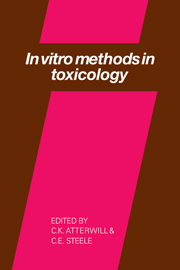Book contents
- Frontmatter
- Contents
- List of contributors
- Preface
- Introduction
- TARGET ORGAN TOXICITY
- In vitro methods in renal toxicology
- Ototoxicity
- Cultured cell models for studying problems in cardiac toxicology
- Use of the isolated rat heart for the detection of cardiotoxic agents
- Brain reaggregate cultures in neurotoxicological investigations
- Application of thryoid cell culture to the study of thyrotoxicity
- In vitro methods to investigate toxic lung disease
- Metabolism and toxicity of drugs in mammalian hepatocyte culture
- In vitro evaluation of haemic systems in toxicology
- GENERAL AND TOPICAL TOXICITY
- REPRODUCTIVE TOXICITY
- CONCLUSION
- Index
Use of the isolated rat heart for the detection of cardiotoxic agents
Published online by Cambridge University Press: 06 August 2010
- Frontmatter
- Contents
- List of contributors
- Preface
- Introduction
- TARGET ORGAN TOXICITY
- In vitro methods in renal toxicology
- Ototoxicity
- Cultured cell models for studying problems in cardiac toxicology
- Use of the isolated rat heart for the detection of cardiotoxic agents
- Brain reaggregate cultures in neurotoxicological investigations
- Application of thryoid cell culture to the study of thyrotoxicity
- In vitro methods to investigate toxic lung disease
- Metabolism and toxicity of drugs in mammalian hepatocyte culture
- In vitro evaluation of haemic systems in toxicology
- GENERAL AND TOPICAL TOXICITY
- REPRODUCTIVE TOXICITY
- CONCLUSION
- Index
Summary
INTRODUCTION
The toxicological development and therapeutic utility of a number of important drugs is frequently limited by their potential for cardiotoxicity. Such side effects may develop acutely or chronically and can range from minimal electrocardiographic (ECG) changes to permanent cardiac damage, or even sudden death (Marshall and Lewis, 1973). Inevitably much time and effort has been spent investigating ways to improve the predictability of myocardial involvement. This has resulted in the proliferation of often complex animal models (Rona, 1967; Balazs et al, 1969; Osborne and Dent, 1973; Chappie et al, 1976), and highly sophisticated schemes of clinical monitoring (Lahtinen et al, 1982). The detection of cardiotoxicity nevertheless remains complicated by the large functional reserve of the heart which can mask mechanical impairment, its ability to develop resistance to further damage after certain insults (Joseph et al, 1983) and also to repair foci of myocarditis (Lehr, 1972; Bach and Cockburn, in press).
Damage to the heart generally occurs either as a consequence of direct cellular toxicity or due to remote effects on the neural, humoral and haemodynamic influences which normally control it. The latter indirect toxicity is frequently seen as a result of exaggerated pharmacological response at the high dose levels commonly used in routine toxicological studies (Herman et al, 1979).
While the toxic end point may be the same it is important to appreciate and differentiate these mechanisms when assessing the significance of cardiotoxicity.
Information
- Type
- Chapter
- Information
- In Vitro Methods in Toxicology , pp. 109 - 132Publisher: Cambridge University PressPrint publication year: 1987
Accessibility standard: Unknown
Why this information is here
This section outlines the accessibility features of this content - including support for screen readers, full keyboard navigation and high-contrast display options. This may not be relevant for you.Accessibility Information
- 1
- Cited by
